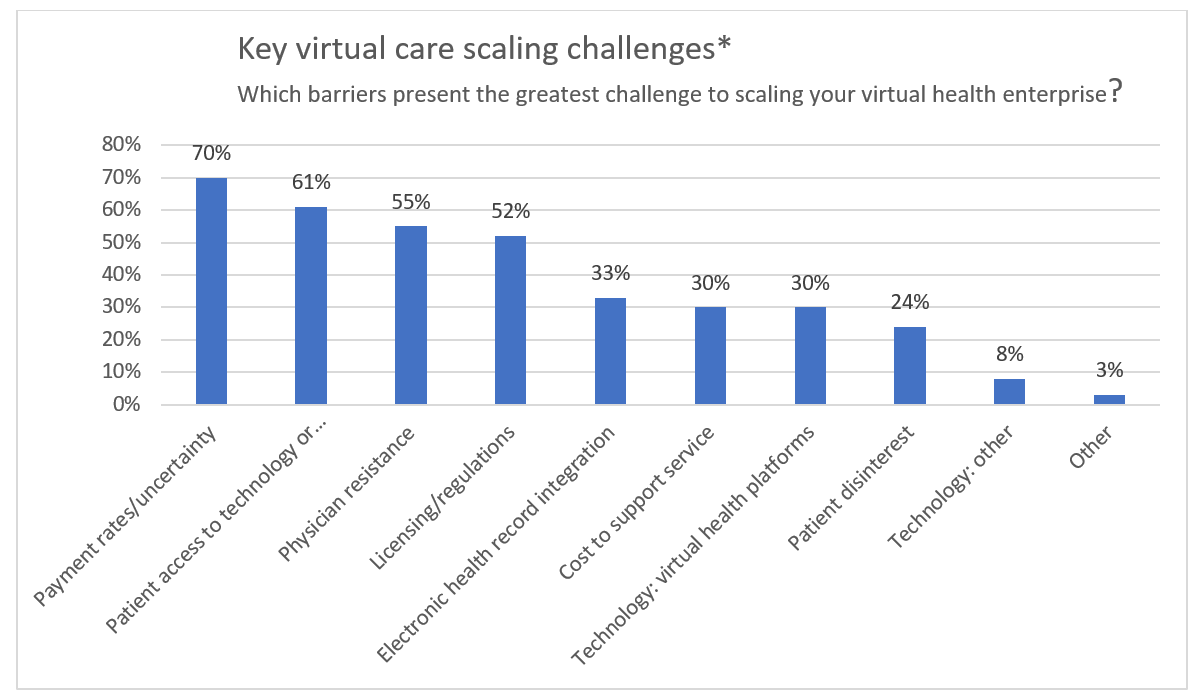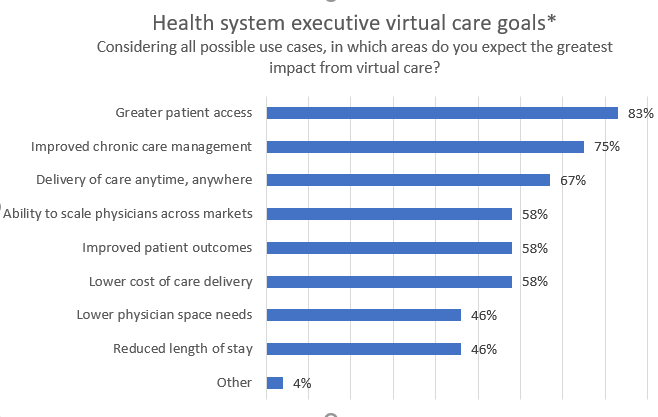Telemedicine is exploding, but where is the ROI for health systems?


From left to right: Ezra Mehlman, MBA, and Dave Tamburri, MBA
Telehealth is well on its way to having much broader acceptance and use than was seen at any time prior to the COVID-19 crisis. Yet there continue to be barriers and challenges in its widespread adoption.
As health systems raced to expand access, retain patients and deliver critical services virtually in response to the COVID-19 crisis, the growth of telemedicine was well documented. The combined effects of relaxed regulation, increased demand and ubiquitous accessibility of cloud-based technologies catalyzed what could be characterized as “digital health’s crowning moment.”
The pandemic created the need for remote healthcare, enabling nascent telemedicine initiatives and companies to take advantage of the untapped receptivity among many patients and physicians to engaging in virtual encounters. In March and April of this year alone, 22 telehealth companies raised venture capital.a
Nonetheless, sweeping questions remain around the economic viability of the telehealth model for health systems. As leaders of cash-constrained health systems prepare for the post-COVID-19 future, with its vision of virtual care woven into the fabric of the U.S. delivery system, they can achieve that vision only by pursuing a financially sustainable business model. To help inform such efforts, we spoke with executives of health systems that are among the nation’s leaders in delivery of telehealth services. These leaders shared with us the economic models their organizations are using to chart a course to a successful ongoing virtual enterprise.
Defining a growing category
The executives underscored the rapidity with which their organizations have scaled up their telehealth services.
R. Henry Capps, Jr., MD, FAAFP, senior vice president and chief digital health and engagement officer of Novant Health in North Carolina, said, “Virtually overnight, Novant Health scaled its daily video visits from an average of two to more than 7,000 — accelerating adoption of digital technology and ensuring revenue streams continued.”
Since March 1, the health system has conducted more than 200,000 video visits.
It is important to define how the concept of “video visits” in this context fits with the overarching definition of telehealth, as discussed in this article. Here we use the term telehealth interchangeably with the idea of virtual care. The term encompasses any clinical encounter that does not involve a face-to-face visit between a patient and a clinician. It therefore includes video, phone, text, email, and online self-service, and it has varying levels of intensity, such as live consult, asynchronous visits (where the patient transmits information to the physician, who reviews the information at a later time) and remote patient monitoring.
The ability to quantify ROI around virtual care initiatives also requires a clear understanding of the capabilities needed to perform the various activities involved with telehealth services across the patient care continuum. In the exhibit below, we have charted 71 discrete capabilities along the patient journey continuum for which virtual care use cases have emerged.
Virtual care capability chart mapping activities across the continuum of care
Pre-encounter |
Population management |
|
Research and selection |
|
|
Evaluation and prep |
|
|
Encounter |
Care delivery |
|
Documentation support |
|
|
Inpatient interaction |
|
|
Discharge |
|
|
Care management |
|
|
Post-encounter |
Care management |
|
Billing |
|
|
Caregiver support |
|
|
Self-management |
|
|
Provider support |
|
Source: Health Enterprise Partners LP, 2020
Six economic models for virtual care
Despite recognition of telehealth’s promise, the path toward widespread deployment of virtual care, both within and outside of the COVID-19 crisis, has posed significant challenges for leaders. Not surprisingly, two of the top 10 virtual care barriers most frequently cited by executives center around issues of revenue and cost, as shown in the exhibit below.

Source: The Academy, May 2020 survey of executive leaders from the largest U.S. health systems
Against this backdrop of muddled unit economics, technical barriers and the ever-present hurdle of driving patient and physician behavior change, several leaders have worked diligently to quantify the ROI from their virtual care efforts. Here, we profile six use cases, based on these executives’ comments.
1. Leverage the digital front door for patient acquisition. On the front end of the virtual care continuum, we see a broad array of self-service functionality, including symptom-checking, provider search, scheduling, pre-registration, visit planning and patient financing. These functions that are frequently used by patients in the form of a chatbot on a health system’s website have proven to be effective tools in recruiting patients online. By establishing a personalized dialogue with a patient about their medical condition, a health system can create a dramatically stickier web presence, increasing the conversion rates of patients accessing online content.
The contribution margin generated by such patients allows leaders to justify spend on digital front-door functionality. In the wake of COVID-19, which caused the use of chatbots to skyrocket as an entry point for virtual and in-person visits, many executives look to this investment as an initial low hanging fruit in the telemedicine space.
2. Leverage telehealth to recoup post-surgical volumes. When elective procedures were canceled, many health systems braced for an erosion of volumes. At its trough in late March, a cohort of 51 health systems experienced a greater than 54% loss of such procedures.b Constrained by internal policies and regulations on rebuilding their inpatient census, many leaders turned to telehealth as a means to recoup some of the post-surgical follow-up visits that might have otherwise been lost. By pursuing an outbound video visit campaign, these executives were able to drive incremental revenue to their organization and increase patient adherence to care plans. Although some of these visits were subject to a 90-day surgical global payment and thus not eligible for additional payment, several health systems cited the initial exposure to virtual care that these follow-up visits created as a leading indicator of downstream telemedicine volumes.
3. Automate care plans through asynchronous messaging to reduce cost and improve quality. Several health leaders have rolled out care plan automation programs centered around hyper-personalized communications before and after a clinical encounter, mirroring the types of immersive mobile experiences found in other industries.
For example, Advocate Lutheran General Hospital in Park Ridge, Illinois, leveraged a mobile platform to manage interactions between patients and their care teams as part of its Perioperative Surgical Home/Enhanced Recovery After Surgery program in the digestive disease service line. By standardizing care protocols and order sets into a mobile experience, clinicians can send personalized messages, assessments and other useful patient information according to predefined pathways. The result has been savings of $1,298 per procedure, driven by a 30% reduction in length of stay and a 38.2% reduction in preventable 30-day readmissions. The team also observed a 74% reduction in surgical site infection rates for a particular wound class.
4. Implement acute virtual care to recruit and retain high acuity inpatients. Although the industry has been largely focused on examining how to leverage telehealth to extend the reach of health systems into patient homes, there is an equally compelling financial case for the use of inpatient telemedicine. By deploying hard-to-recruit specialists into an inpatient setting, typically through a video cart, tablet or bedside monitor, executives can add service lines to hospitals where the barriers to providing these services on in-person basis would be insurmountable.
Lynne Falcone, MHA, CEO of Cuero Regional Hospital in Cuero, Texas, elaborated on her hospital’s use of telehealth in cardiology: “With our telecardiology service line, in less than a year, our hospital retained 100 patients whom we ordinarily would have lost to other facilities. The return on investment is clear not only for our hospital but for our patients who now have access to the care they need close to home.”
5. Implement inpatient telehealth to reduce locum tenens staffing costs. Beyond the revenue and patient satisfaction increases that a health system can obtain from using inpatient telemedicine is the opportunity to reduce staffing costs. To provide a broad array of clinical services, hospital leaders, particularly those in rural or remote environments, often use expensive temporary staffing resources. Our industry survey found that some health systems were able to reduce spend on staffing by 30% or more for certain service lines by leveraging telemedicine as an alternative to a staffing agency. Although the lower cost of relative ownership and incremental revenue are the most easily quantifiable benefits associated with inpatient telemedicine, other key benefits that were cited included reduced transfers and improved clinical quality associated with caregiver continuity.
6. Use remote patient monitoring (RPM) to expand the reach of care teams. As health system executives in hotspot markets sought to free up their inpatient capacity at the initial peak of the COVID-19 crisis, many turned to innovations in RPM. By leveraging connected devices such as pulse oximeters and thermometers to monitor patients, at scale, from their own beds, several health systems were able to dramatically improve their nurse-patient staffing ratios and open up inpatient beds for those in duress.
Sara Vaezy, MPH, MHA, chief digital strategy and business development officer at Providence St. Joseph Health in Seattle, cited a greater than fourfold improvement in staffing ratio made possible by having patients input their indicators remotely. The nurse-to-patient ratio increased from 1:25 to 1:100.
Bolstered by the success of such initiatives, many leaders have been exploring other RPM use cases. Among executives responding to a survey by The Academy, a peer learning company based in Arlington, Virginia, 88% said they plan to significantly scale RPM beyond the COVID-19 pandemic.
The path forward
So where does this all leave us?
Does Seema Verma’s assertion on telehealth that “The genie’s out of the bottle on this one” suggests we will see a limitless expansion of virtual care that will eventually supplant face-to-face visits as the preferred site of service for all concerned? It is likely the answer to this question is deeply rooted in the financial conditions of health systems. We have seen COVID-driven volume losses deal hospitals a crushing blow. In this environment, pursuing an economically sustainable virtual care strategy, anchored in compelling unit economics and tied closely to patient and physician preferences, will be critical.
As elective procedures and outpatient visits slowly phased back in for many health systems, the proportion of telehealth visits to total visits began falling in mid-April, with health system executives racing to boost volumes through traditional mean.
Deceleration of telehealth vists
Source: Mehrotra, A., Chernew, M. Linetsky, D., Hatch, H., and Cutler, C., “The impact of the COVID-19 pandemic on outpatient visits: practices are adapting to the new normal,” The Commonwealth Fund, June 25, 2020.
Source: Mehrotra, A., Chernew, M. Linetsky, D., Hatch, H., and Cutler, C., “The impact of the COVID-19 pandemic on outpatient visits: practices are adapting to the new normal,” The Commonwealth Fund, June 25, 2020.
Even if telehealth utilization were to plateau at 10% of total visits, this would represent at least a 1,000% increase for many health systems. While the jury is out on what the steady-state ratio of virtual to in-person visits will be after the pandemic, telemedicine is certain to remain a core care modality moving forward. Hospitals therefore need to find ways to make bulletproof business cases for virtual care and to identify the ideal blend of virtual and physical touch points for each patient type.
Brian Contos, general manager, The Academy, elaborates: “Besides securing permanent, adequate payment and flexibility on how and where virtual visits are offered, another key factor in adoption is how well providers integrate virtual care with in-person visits. There’s no one-size-fits-all approach for hybrid virtual and in-person delivery. There is easily a dozen or more care pathway archetypes plus nuances for each patient’s unique circumstances.”
Footnotes
a. Healthcare Growth Partners, “COVID-19: Telemedicine’s Catalyst,” May 4, 2020.
b. Mehlman, E., Lefar, S., “Elective surgery does not mean optional surgery: How to recover from the impact of cancelled procedures,” HFMA, Financial Sustainability Report, June 2020.
Health system executive priorities for telehealth
As we identify the use cases along the continuum where health system leaders have been able to reap the most clinical and financial value, we must first understand the goals that underlie provider telehealth initiatives. A recent survey of health system leaders conducted by The Academy found that the objectives most cited by respondents were:
- Increasing patient access (83%)
- Bolstering chronic care management (75%)
- Delivering care anytime, anywhere (67%)

Source: The Academy, May 2020 survey of executive leaders from the largest U.S. health systems
Among the executives we interviewed for this article, there was tremendous convergence in the aims they are pursuing through their respective virtual efforts.
Nick Reddy, chief digital officer and senior vice president of information services at Baylor Scott & White Health in Texas, said: “First, I think virtual for us is a patient acquisition tool — we track this closely. The value is clearly here if you focus on cost of delivery on how you build this business versus focusing on revenue and making sure we get paid the same for virtual versus physical. Second, it’s a patient satisfaction/convenience tool for existing patients that are not coming in — so remote monitoring, hospital at home, etc. Third, it can be used to drive cost of care down for capitation patients. This includes remote monitoring for Medicare Advantage Patients and post-surgery care for patients in bundled contracts.”





